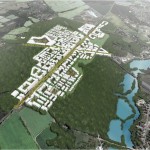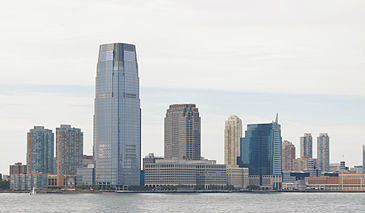New Jersey Future Blog
Accommodating Growth in Mercer County
August 11th, 2011 by Elaine Clisham
- According to the Delaware Valley Regional Planning Commission, Mercer County is projected to add 27,238 new residents between 2010 and 2035, going from 376,738 to 403,976, a 7 percent increase; and add 33,088 jobs between 2010 and 2035, going from 236,358 to 269,446, a 14 percent increase, or double the rate of increase in population.
- A Rutgers study of the Route 1 corridor in Middlesex and Mercer counties projected that by 2025, the number of congested lane miles in the area is projected to grow from 13 percent to 36 percent.
- In 1995, Mercer County had 52,975 acres of “available” land (that is to say, not yet developed and not permanently preserved or environmentally constrained). As of 2007, the number of available acres was down to 26,077, a 50 percent drop.
Redevelopment is the Answer
The numbers illustrate what many in Mercer County already know: Development pressures in the county are likely to increase in the next 25 years, only exacerbating traffic and loss of open space. Redevelopment is one way to address this problem, by accommodating new growth in areas with existing development and infrastructure. For example, Mercer County has seven rail transit stations: five served by commuter rail and two along the River Line light rail. Most of these offer the potential for new transit-oriented development. Vacant properties and open surface parking areas in both urban and suburban communities also offer opportunities to reuse already-developed land.
Overcoming Resistance
Despite all of their benefits, redevelopment projects face many hurdles. Some of these hurdles are technical or financial, but many times they are grounded in local opposition. Several prominent redevelopment efforts in the county have stalled, in part because of public resistance. In an attempt to gain a deeper insight about Mercer County residents’ attitudes towards redevelopment, New Jersey Future convened two focus groups in June and July 2011, comprising interested citizens of the county, to try to gain insight into how residents feel about certain aspects of redevelopment, where they get their information about redevelopment initiatives near them, and how they perceive the future of their county. The results were illuminating.
First, everyone acknowledged that Mercer County will continue to grow, and that growth will present unavoidable challenges. Most predicted that population diversity would increase, urban areas would expand outward, and there would probably be some municipal consolidation. They saw as common goals the preservation of open space and farmland; reduced reliance on auto-centered transportation, especially in light of rising gas prices; the creation of safe, enjoyable neighborhoods and the revitalization of distressed areas.
Participants agreed that the key to accomplishing these goals in ways that address residents’ concerns is to begin with a bottom-up vision for the community that reflects the needs and aspirations of all its residents. That vision should drive decision-making around all redevelopment initiatives; to the degree that an initiative aligns with the vision, the community is more likely to support it.
Communication and Trust are Required Elements
Participants saw two significant barriers to successful implementation of a community vision. The first is a perceived lack of interest and engagement in redevelopment issues among fellow residents, until perhaps the threat of change brings out their opposition; and the second is a lack of trust between residents and those who are charged with communicating about such initiatives. This lack of trust encompasses public officials and developers, who are often seen as acting in each others’ best interests rather than those of the community; and the media, who were criticized for poor, superficial, late-in-the-game coverage of redevelopment issues if indeed those issues were covered at all. Informed neighbors – “people like me” – turned out to be the most highly trusted sources of information.
Effective, transparent and trustworthy communications at all stages of the project emerged as a critical community need. Residents have to be reassured that their interests are being furthered and that the coming changes will enhance rather than threaten their current quality of life. Taking the time to craft a comprehensive communications strategy that earns the trust of residents will go a long way toward ensuring a redevelopment project’s success.
If you have any questions about this issue of Future Facts, please contact Communications and Outreach Associate Elaine Clisham (eclisham njfuture
njfuture org) .
org) .
Read more about New Jersey Future’s work, or become a member. For more information, please contact Dan Fatton (dfatton njfuture
njfuture org) at 609-393-0008 ext. 105.
org) at 609-393-0008 ext. 105.


















I know I sound like a broken record, but…
Three decades of work in oommunity development revealed in case after case that the most serious problem we faced was a dysfunctional land market. Land speculators always seemed to get the upper hand and demand a ransome price for key land parcels. The reason this was possible is that the effective rate of taxation on the rent of land (that is, what land would yield in revenue under a competitively-obtained lease) is almost universally low or in the worst case even close to zero. A high annual tax that publicly collects the full rental value of locations is the only means of solving the problem; yet, landowners have been very adept in avoiding this restructuring of the property tax. So, what do communities and school districts do? They impose heavy rates of taxation on property improvements until investment is driven away altogether. Then, the landowners wait for public subsidies to development that are capitalized into higher land prices.
If the design and marketing concept is good enough, pay the price because the project can afford it . Great that the property is available, so they make a profit,so what … Far better than the old lady who will not move lest her cats be disturbed … If the marketing and design concept is not good enough you already failed
On a different note, “urban areas will continue to expand outward” is a paradigm that really needs to change, particularly when Trenton sits at about 2/3rds its historic high population level. It’s time to focus our urban areas inwards!
I’m just loosely recalling figures I’ve previously researched several years ago but I think all of that projected population increase could be absorbed into Trenton and it wouldn’t even exceed its historic high population numbers.
The article carefully avoids the issue of the use of eminent domain.
In the past 10 or 15 years in New Jersey, “redevelopment” has meant using eminent domain as a weapon to attack homeowners (owner occupied single family houses) and take their land land against their will, then bulldozing their family homes off the face of the earth, in order to benefit other private parties (developers.)
Until “redevelopment” means ‘never forcing a homeowner out of their home against their will,’ it’s going to be fought against tooth-and-nail, and rightly so.
I may be wrong on this, but I believe the State Legislature dealt with the misuse of “eminent domain” a few years ago. The taking of privately-held property for public purposes is sometimes controversial but the principle is the right one. The ownership of land is appropriately conditional (i.e., such ownership is what John Locke described as a privilege granted by society via the instrument of government).
With population growth comes changing land use patterns. The “highest, best use of land” requires higher-density development and universally imposes the costs of new infrstructure on the residents and businesses. Land values increase generating windfall (i.e., unearned) gains in the market price of land assets. In most instances, increases in land value are not reflected in updated property assessments for tax purposes. Thus, the property tax has a strong bias against property improvemtns (i.e., buildings) while rewarding land speculators and owners of large tracts of land. A land-only property tax base would go a long way toward ending this problem — and simultaneously put a strong deterrent on sprawling development patterns.
To address the problem you raise of people being forced out of their homes because of large-scale redevelopment, one good approach is to require the developer and redevelopment authority to allocate new housing for affected households. Property owners are supposed to be paid market value for any property taken as a result of redevelopment.
Public officials are now required by law to include local residents in the planning process.
I have to comment on this, because we (Franklin Township, Somerset Co.) have a redevelopment area (established 1998, but only now actually being redeveloped). Redevelopment, in the sense of replacing single family homes and vacant urban land with three- or even four-story apartment buildings, is essential to avoid further sprawl and concentrate housing where there is access to public transportation. It is also a stimulus to existing downtown retail areas within walking distance; indeed, this should be an essential aspect of planning redevelopment.
‘Eminent domain’ are dirty words, and redevelopers do everything they can to avoid using it (or rather, having the municipality use it). At least one of our Council feels that even when it is not used, the threat is there. It is only usable in ‘blighted’ areas, and the NJ Supreme Court recently tightened up the definition of ‘blighted’; but it remains a tool to deal with sheer obstinacy. (So far as I know our redevelopers have not used it.) Redevelopers should do everything possible to assist displaced residents in finding new housing they can afford.
Our redevelopers have so far built mainly low & moderate income housing, using Low-income Housing Tax Credit equity and Federal Home Loan Bank AHP money to keep their costs down, and fulfilling our COAH obligation. But they are specialized in building such housing, and now we want to move beyond that, to market-rate housing and retail stores. How we get this to happen is our next problem. In general, builders should now be focusing on apartment construction, for the people who can’t get a mortgage or have lost their home to foreclosure. Will builders who have waxed fat building green-field single family home developments be able to switch to apartment construction in development areas? We may see a survival of the most adaptable.
A strong supporter of NJ Future, I just moved from my bucolic acre of highly-taxed property in Lawrenceville, NJ, to the vibrant center of Washington, D.C.
Even when I first moved to Lawrenceville, I tried to find something in Princeton or Trenton first; at almost 60 then & battling terminal cancer, I wished I could go to a movie, or a museum, or a store without a car & even 15 minutes of travel. I had previously lived in Westfield & Maplewood, which at least had vibrant downtowns within walking distance.
I lived in D.C. 40 years ago, and it has become noisy, confusing, and expensive, and worth it. I’m alive here.
And many of my cohorts are expressing the same views. An urban environment provides older people with the opportunity to live out their lives with so much more of the things that make a life worthwhile.
Would proposed redevelopment needs affect the roads and properties that are currently car dealerships by Quaker Mall? I believe one is called Coleman Buick-GMC, and the other is Superior Chevrolet.
What would the future ramifications be to that area?
Thanks, Mike